Speed has always captivated the imagination of aviation enthusiasts, pushing engineers and pilots to design aircraft that can break through the sound barrier and reach incredible velocities. In this article, we delve into the realm of speed and explore the ten fastest planes in the world. From cutting-edge experimental aircraft to legendary fighters, these speed demons have left an indelible mark on aviation history.
List of the 10 Fastest Planes in the World
The 10 fastest planes in the world are North American X-15, Lockheed SR-71 Blackbird, Lockheed YF-12, Mikoyan MiG-25 Foxbat, Bell X-2 Starbuster, XB-70 Valkyrie, Mikoyan MiG-31 Foxbat, McDonnell Douglas F-15 Eagle, General Dynamics F-111 Aardvark, and Sukhoi Su-27 Flanker.
North American X-15, the fastest plane in the world
The North American X-15 takes pride of place as the fastest airplane in the world. Developed in the 1950s and 1960s, this rocket-powered aircraft reached astonishing speeds, exceeding Mach 6.7.

Launched from a B-52 mother ship, the X-15 featured retractable landing gear and a unique lower fin jettisoned before landing. It also executed various flight scenarios, including ballistic flights into space. Pilots wore pressure suits and relied on reaction control and stability augmentation systems in the thin air. It flew 199 test flights between 1959 and 1968, reaching altitudes above 100 kilometers twice, marking the edge of space. Today, two X-15s are on display at prestigious museums.
Lockheed SR-71 Blackbird ( Mach 3.3)
The Lockheed SR-71 Blackbird remains an enduring symbol of speed and technological prowess. Designed as a reconnaissance aircraft, it cruised at speeds surpassing Mach 3.3, or over 2,193 mph, and altitudes of 85,000 feet. Remarkably, it held the title of the world’s fastest and highest-flying air-breathing crewed aircraft.
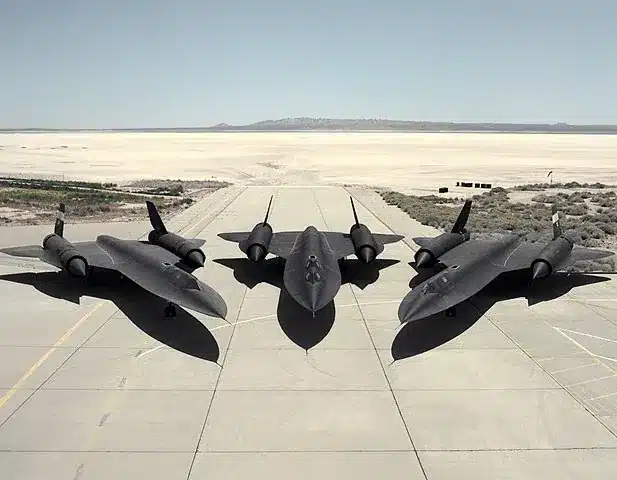
Introduced in 1966 The SR-71 was initially conceived as a reconnaissance aircraft but briefly considered for bomber roles. Ultimately, it became a symbol of strategic reconnaissance excellence, equipped with advanced sensors, radar, and cameras. Its sleek design, evolved from the A-12, reduced radar visibility, and its two-seat cockpit accommodated both pilot and reconnaissance officer.
Despite its 32 aircraft fleet, only 12 were lost in accidents, none to enemy action. Political factors led to its retirement in 1988, with brief reactivations in the 1990s. NASA continued its legacy until 1999.
Today, reconnaissance has shifted to satellites and UAVs, but the SR-71’s legacy endures, with the SR-72, its proposed successor, in development.
Lockheed YF-12 (Mach 3.2)
The Lockheed YF-12, a sibling of the legendary SR-71 “Blackbird,” emerged during the 1960s as a high-speed interceptor with astonishing capabilities. It is one of the fastest airplanes in the world. Developed by Lockheed’s Skunk Works division, the YF-12 showcased its prowess by intercepting targets at Mach 3.2 speeds and altitudes of 85,000 feet.

Armed with AIM-47 Falcon missiles, it demonstrated its firepower by downing a target at low altitude. The YF-12 program, while ultimately canceled due to cost concerns and changing priorities, yielded valuable technological advancements. Its legacy lives on in subsequent supersonic aircraft and contributed significantly to the advancement of aerodynamics and materials science.
Bell X-2 Starbuster
The Bell X-2, known as “Starbuster,” was a rocket-powered research aircraft designed to investigate aerodynamic heating effects, stability, and control at high speeds and altitudes.
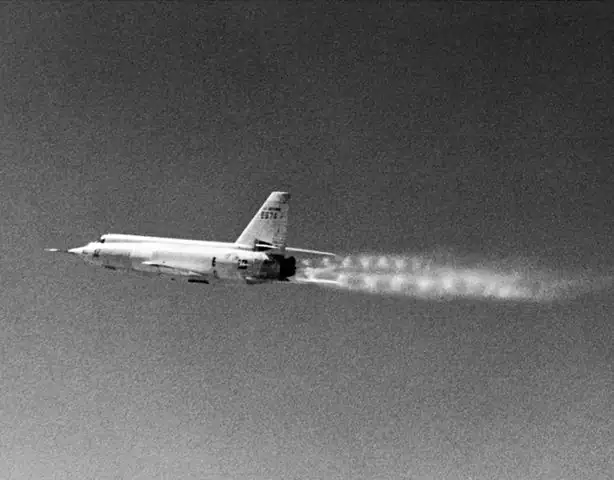
Developed in 1945 through a collaboration between Bell Aircraft Corporation, the U.S. Air Force, and the National Advisory Committee for Aeronautics (NACA), it aimed to explore supersonic flight challenges beyond the X-1 series. Two X-2 airframes were constructed with stainless steel and K-monel, powered by a Curtiss-Wright XLR25 liquid-fueled rocket engine. On September 27, 1956, pilot Captain Milburn Apt set a record, exceeding three times the speed of sound at 2,094 mph (Mach 3.196), but a tragic turn caused a fatal control issue known as inertial coupling, resulting in his death, overshadowing the program’s achievements.
Mikoyan MiG-25 Foxbat
The Mikoyan MiG-25 Foxbat, a Soviet masterpiece, demonstrated its prowess as a high-speed interceptor. Its normal speed was 2.83 but it could reach a maximum speed of Mach 3.2.

As the Cold War’s opening years ushered in the era of intercontinental bombers, the Soviet Union needed a way to counter the U.S.’s formidable bombers. The result was the MiG-25, an aircraft that relied on brute force to catch its prey.
The MiG-25’s powerful engines were adapted from turbojets originally built for cruise missiles and reconnaissance drones. These engines, while enormous, had a short service life, and the aircraft had to withstand extreme kinetic heating during high-speed interceptions. To keep costs down and simplify maintenance, the MiG-25 was constructed primarily from heavy nickel-steel alloy rather than lightweight titanium.
This interceptor was equipped with a massive 600-kilowatt radar capable of detecting high-flying targets up to 100 kilometers away and defeating jamming devices. Its armament consisted of four of the largest air-to-air missiles ever produced. The Soviet Union mass-produced this aircraft, with 100 MiG-25s rolling off assembly lines each month at its peak.
The MiG-25, despite initial concerns, served primarily as an interceptor, not a dogfighter, and excelled in this role. It set numerous world records for speed and altitude, many of which remain unbroken. The aircraft’s legacy lies in its influence on the subsequent development of Soviet interceptors and air defense systems. The Soviet Union moved on to create the MiG-31, a more advanced interceptor that incorporated cutting-edge technology.
XB-70 Valkyrie
The XB-70 Valkyrie was a prototype of the B-70 strategic bomber, designed for deep-penetration supersonic missions by the United States Air Force Strategic Air Command in the late 1950s. The Valkyrie, powered by six engines, could cruise at a maximum speed of Mach 3.1 and fly at an altitude of 70,000 feet for thousands of miles. In 1966, one prototype crashed in a collision while flying in formation.
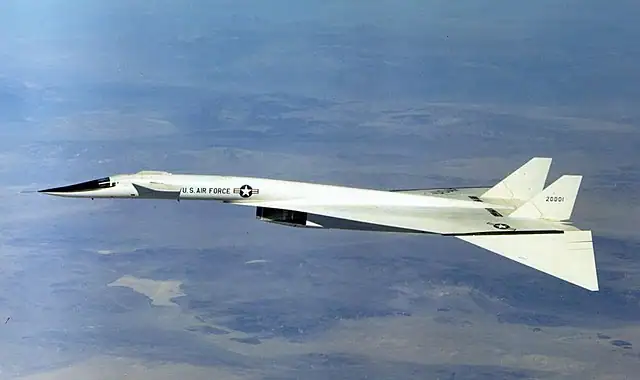
Today, the remaining Valkyrie is on display at the National Museum of the United States Air Force in Ohio. It featured a canard surface, a delta wing, and utilized advanced supersonic technologies, including a modified form of the Navaho’s inertial guidance system. The USAF abandoned its production, leading to the B-70 program’s cancellation in 1961, repurposing it for research on long-duration high-speed flight. Two XB-70A prototypes were built and used for supersonic tests between 1964 and 1969.
Mikoyan MiG-31 Foxhound
The Mikoyan MiG-31, also known as the “Foxhound” by NATO, is a supersonic interceptor aircraft developed as a replacement for the MiG-25 “Foxbat” by the Soviet Air Forces. The MiG-31BSM variant can maintain a cruise speed of 3,000 km/h (Mach 2.5) over extended distances without sustaining any damage.
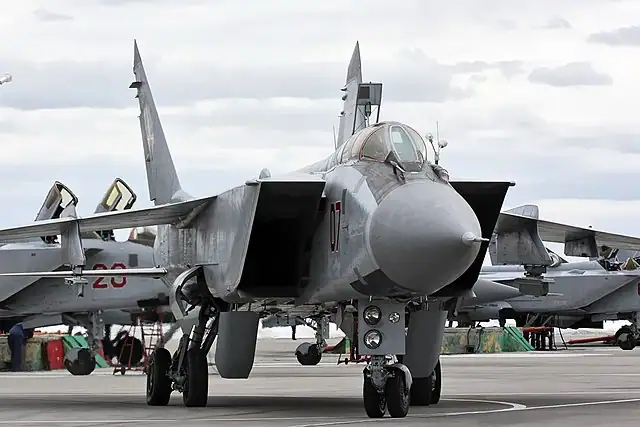
Based on the MiG-25, the MiG-31 is one of the world’s fastest combat aircraft. It remains in operation with the Russian Aerospace Forces and Kazakh Air Defense Forces, with plans to continue its service until at least 2030. The MiG-31 features two seats, with a dedicated weapon systems officer in the rear. It boasts a passive electronically scanned array (PESA) radar, the Zaslon S-800, and can track multiple targets, attacking four simultaneously with Vympel R-33 missiles. Introduced in 1981, it’s designed for high-speed interception rather than close combat.
McDonnell Douglas F-15 Eagle
The McDonnell Douglas F-15 Eagle, a twin-engine, all-weather tactical fighter, was developed by McDonnell Douglas (now a part of Boeing) and selected by the United States Air Force (USAF) in 1969 as a dedicated air superiority fighter. The F-15 made its first flight in July 1972 and entered active service in 1976. It stands as one of the most successful modern fighters, boasting over 100 victories in aerial combat. The USAF is the primary operator of the F-15, which continues to be a stalwart in military aviation.
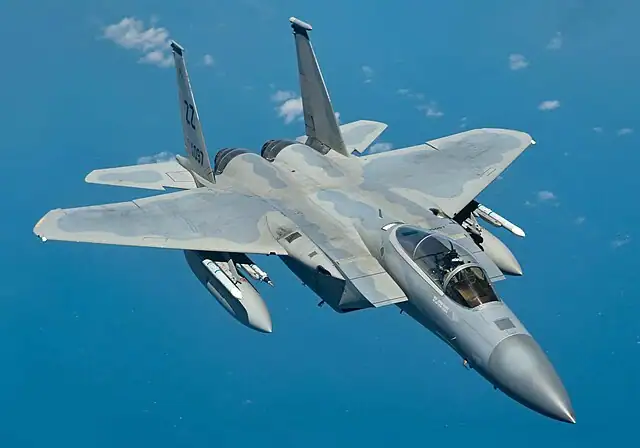
The aircraft features Pratt & Whitney F100-PW-220 afterburning turbofans, enabling a maximum speed of Mach 2.5, a combat range of 1,061 nautical miles, and a service ceiling of 65,000 feet. Its g limits are +9, and it has a thrust-to-weight ratio of 1.07.
General Dynamics F-111 Aardvark
The General Dynamics F-111 Aardvark, a retired multirole combat aircraft, introduced pioneering features in the 1960s under Robert McNamara’s TFX Program. It had variable-sweep wings, afterburning turbofan engines, and automated terrain-following radar for low-level, high-speed flight.
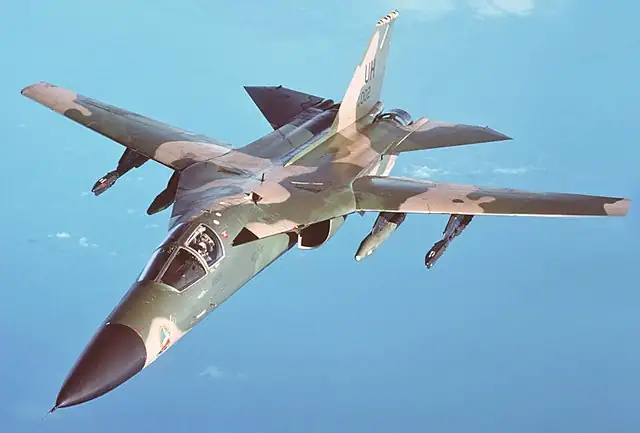
The F-111 was an all-weather attack aircraft with roles encompassing attack, strategic bombing, reconnaissance, and electronic warfare. Its variable-geometry wings could sweep from 16 to 72.5 degrees, and it featured leading edge slats, double slotted flaps, and side-by-side cockpit seating. The aircraft’s performance stats included a maximum speed of Mach 2.5, a range of 3,210 nautical miles, and a service ceiling of 66,000 feet. The F-111 significantly influenced subsequent swing-wing aircraft.
Sukhoi Su-27 Flanker
The Sukhoi Su-27, known by its NATO designation as the Flanker, is a formidable Russian air-superiority fighter aircraft. It was first introduced into the Soviet Air Force in 1985 and has since become a premier fighter in the arsenals of various nations, including Russia, Ukraine, Belarus, Kazakhstan, Uzbekistan, Indonesia, India, China, and Vietnam.

Development of the Su-27 began in 1969 at the Sukhoi design bureau in response to the American F-15 Eagle. Over time, under the guidance of chief designer Mikhail Simonov, the Su-27 evolved into an exceptional air-superiority platform, renowned for its large size, twin turbofan engines, remarkable agility, supersonic capabilities, high service ceiling, and an impressive arsenal of weaponry, including air-to-air missiles, air-to-ground rockets, bombs, and a 30-mm gun firing exploding shells. With a flight range of over 3,000 kilometers (1,800 miles) and the ability to fly at more than twice the speed of sound (Mach 2.35 maximum speed), the Su-27 has left an indelible mark on 21st-century aviation history.
Summary of the 10 Fastest Planes in the World
The ten fastest airplanes in the world, from the North American X-15 to the Sukhoi Su-27 Flanker, have left an indelible mark on aviation history. These remarkable aircraft have shattered speed barriers, pushed the boundaries of engineering, and inspired generations of aviators and engineers. From experimental rocket-powered aircraft like the X-15 and Bell X-2 Starbuster to iconic reconnaissance planes like the SR-71 Blackbird, each aircraft represents a triumph of human ingenuity and technological advancement.
These speed demons have not only broken records but have also shaped the future of aviation. They have provided invaluable insights into hypersonic flight, advanced aerospace technologies, and influenced the design of modern fighters and bombers. The lessons learned from these groundbreaking aircraft continue to propel us towards even greater achievements in the realm of speed and performance.
FAQs: Fastest airplanes in the world
Q: Which is the fastest plane in the world?
A: The North American X-15 is the fastest plane in the world, reaching speeds exceeding Mach 6.7 (7,274 km/h). It was developed by NASA and USAF during the 1950s and 1960s for experimental purposes.
Q: How fast is the fastest airplane in the world?
A: The fastest airplane ever built is the North American X-15, which reached speeds exceeding Mach 6.7 (7,274 km/h). It was a rocket-powered experimental aircraft used by NASA and the USAF for various tests and experiments.
Sources
- Jane’s All the World’s Aircraft
- NASA Bell X-2 Starbuster Fact Sheet
- Britannica
- Landis, Tony R., ed. (23 November 2020). A Look Back… NAA B-70 Valkyrie Variants, A Future That Never Was…








The SR-71 is such an iconic plane. I remember when I was a kid in the 80s, I had jet trading cards and the SR-71 was always at the top of the pile.